
Jeremy Bishop | Unsplash

Explore resources and ADL's impact on the National Strategy to Counter Antisemitism.
Over the past year, online hate and harassment rose sharply for adults and teens ages 13-17. Among adults, 52% reported being harassed online in their lifetime, the highest number we have seen in four years, up from 40% in 2022. Both adults and teens also reported being harassed within the past twelve months, up from 23% in 2022 to 33% in 2023 for adults and 36% to 51% for teens. Overall, reports of each type of hate and harassment increased by nearly every measure and within almost every demographic group.
ADL conducts this nationally representative survey annually to find out how many American adults experience hate or harassment on social media; since 2022, we have surveyed teens ages 13-17 as well. The 2023 survey was conducted in March and April 2023 and spans the preceding twelve months. Online hate and harassment remain persistent and entrenched problems on social media platforms.

I was attacked for being Jewish, non-binary, lesbian, and deaf. I was tormented with cruel jokes, name- calling, etc. I blocked people, reported the harassment, etc. Facebook and the other platforms did nothing. I closed my accounts and left social media.
A 67-year-old multiracial nonbinary Jewish person
Online harassment can include many types of unwanted or hostile contact on digital platforms–including social media, chat, and email–such as verbal abuse, hate speech, trolling, spamming, impersonation, and defamation. More severe forms include ongoing harassment campaigns, sexual harassment, stalking, doxing, and swatting. By hate, we mean abuse and harassment targeting someone for their identity, specifically as part of a marginalized group.
For ADL’s annual survey of online hate and harassment, we asked respondents in the U.S. whether they’ve experienced any of the following on social media: been called offensive names; had someone try to embarrass them purposefully; been physically threatened; been harassed for a sustained period; been stalked; been sexually harassed; been doxed (that is, had someone release private information about them without permission); been swatted (that is, had an emergency service dispatched to their house as a hoax). Severe harassment in this report encompasses physical threats, sustained harassment, stalking, sexual harassment, doxing, and swatting.
ADL’s fifth annual survey shows online hate and harassment rose sharply for both adults and teens ages 13-17 in the past twelve months. Reports of each type of online hate and harassment increased by nearly every measure and within almost every demographic group, making clear that online hate and harassment remain persistent and entrenched problems on social media platforms.
Online hate and harassment surged in the 2023 findings twelve percentage points from 40% in 2022 for adults. More than half (52%) of all American adults reported experiencing hate or harassment online at some point in their lives. Although hate and harassment rose across the board, these increases were most pronounced among Black/African American and Muslim respondents.
Jewish respondents experienced an increase in online harassment from 2022: 44% reported ever being harassed (up from 37%), 31% reported ever experiencing severe harassment (up from 23%), and 26% reported any harassment in the past twelve months (up from 21%). Jewish respondents were also more likely than non-Jews (28% vs. 23%) to worry about future harassment and more likely to worry about being harassed for their religion, 80% compared to 41% for non-Jews. They were also more likely than in past years to avoid identifying themselves as Jewish, including on social media (25% in 2023 compared to 17% in 2022).
The increase in the 2023 findings erased a dip for many demographic groups in 2022. For example, in the past twelve months, Muslim respondents have returned to their 2021 levels of harassment (38%) after a decline in 2022 (23%).
A third of American adults (33%) experienced some form of online harassment in the past twelve months, up from 23% in 2022. Teens ages 13-17 also experienced a sharp rise: 51% of teenagers experienced some form of online harassment in the past twelve months compared to 36% in 2022, an increase of 15 percentage points, greater than the 10 percentage point increase among adults.
ADL has conducted this nationally representative survey annually since 2019 to determine how many Americans experience hate or harassment incidents on social media. This year, we surveyed 2,139 adults 18 and over from March 7-24, 2023, and 550 teens aged 13-17 from March 23-April 6, 2023. Respondents were asked about lifetime experiences as well as experiences in the preceding twelve months.
Given the proliferation of anti-transgender legislation and rhetoric, we oversampled transgender respondents for the first time, a sampling method to ensure enough responses from a small demographic group. We found 76% of transgender respondents have been harassed in their lifetimes, with 51% of transgender respondents being harassed in the past twelve months, by far the highest of any reported demographic category. After transgender respondents, LGBQ+1 people experienced the most harassment at 47% in the past twelve months (together, transgender and LGBQ+ people were the most harassed demographic group every year we have conducted this survey).
Looking at platforms, Facebook was where most harassment took place. Of those who reported being harassed, 54% indicated the harassment took place on Facebook. Harassment rose on Twitter (up to 27% from 21% in 2022) and on Reddit (up to 15% from 5% in 2022).
1. We refer separately to transgender and lesbian, gay, bisexual, and queer or other respondents (LGBQ+) in the adult survey because of the change in our sampling methodology this year, even though they constitute one larger demographic. In the teen survey, LGBTQ+ were sampled together.
What might be behind these alarming results? Hateful rhetoric from political leaders, celebrities, and other public figures often spurs online hate, just as online hate can often spur offline harm.
Political mobilization around transgender rights, reproductive rights, voting rights, and racial justice over the past year has contributed to toxicity and harassment in online spaces. The 2022 midterm elections in the U.S. drove some of this mobilization, including transphobic themes in political campaigns, harassment campaigns against transgender health care, and bills targeting transgender participation in sports and access to gender-affirming care.
The midterm elections also incited extensive election conspiracy theories and misinformation online, many stemming from the 2020 U.S. presidential election. Some politicians fanned concerns about anti-racist educational programs in public schools, pushing back against the alleged teaching of critical race theory and, in 44 states, introducing legislation to restrict or limit how teachers discuss racism and sexism.
There were also multiple high-profile antisemitic incidents in 2022, such as assaults on Orthodox Jews and the hate group Goyim Defense League spreading antisemitic messages through highway banner ads, leaflets, and even projected onto buildings. Rising antisemitic incidents, as tracked by ADL Center on Extremism, as well as highly-visible online antisemitic tirades from influential figures such as Ye (formerly known as Kanye West) and more subtle dog whistles from politicians like former President Trump and some left-wing candidates in the 2022 elections may account for the increase in Jewish respondents’ worries about online hate and harassment.
Additionally, after Elon Musk purchased Twitter and took it private in October 2022, he welcomed back users banned for violating anti-hate policies and dissolved the Trust & Safety Council (of which ADL was a member), a voluntary group of civil society advisors. ADL documented a spike in antisemitism following his takeover in October and has found many of the reinstated accounts spread antisemitism or incite their followers to harassment. Twitter also rolled back rules against anti-transgender hate and, in February, changed its policy of removing violative hateful content to de-amplifying it instead.
At the same time, tech companies had record layoffs, calling into question their ability to moderate hateful content. Google shrunk the team that builds content moderation tools and tracks “threats to open societies,” Twitter dramatically reduced its trust and safety and AI ethics teams, and Meta (Facebook’s parent company) had mass layoffs that disproportionately affected its trust and safety teams.
The consequences of online harassment do not stay online, either. Anti-trans harassment on social media preceded bomb and death threats against hospitals that provide gender-affirming care. The perpetrator of a May 6, 2023 mass shooting in Allen, Texas, that killed seven people posted misogynist, anti-LGBTQ+, and antisemitic hate on social media. While online harassment causes emotional distress, reputational and economic harm, or withdrawal from online spaces, it can equally spill into offline attacks, especially against marginalized groups like women, LGBTQ+ people, people of color, and Jews.
[I] had revenge porn posted along with all of my contact information. Local police were not interested in helping. [I] ended up testifying in San Diego court.”
33-year-old multiracial nonbinary person
ADL has spent decades combating online hate and its harms. Our REPAIR Plan emphasizes six points that lawmakers, industry, and civil society should prioritize to push hate and harassment out of the mainstream. Based on this year's survey findings, we propose the following recommendations to bolster these efforts.
Since ADL’s report on targets of harassment in 2019, we have repeatedly found that tech companies do not provide sufficient tools and resources to prevent hate and abuse, especially harassment campaigns targeting women and people of color. The same is true today. To mitigate hate and harassment, we recommend that platforms do the following:
Ultimately, much of tech operates in a black box, making effective regulation difficult to craft and enforce. This is why governments have a crucial role to play. To mitigate hate and harassment, we recommend lawmakers and regulators do the following:
Tech companies have proven they cannot, or will not, adequately address hate and harassment through self-governance; therefore, the government must step in and create appropriate rules and regulations to increase tech accountability.
This year's survey reaffirms that many individuals face severe online hate and harassment, including threats of physical violence. Too often, targets are left without resources and support to respond to these dire situations. Platforms and governments are well-positioned to address online hate and mitigate its harms. Similarly, policymakers, researchers, and civil society have a crucial role to play as we continue to navigate the complexities of technology's impacts on society. The above recommendations are an important first step to ensuring that online spaces are equitable and safe for all users.
“Photos of me were made into memes. People would make fun of me. I was also contacted in DM. I ignored the person who is still on there with several profiles and does the same to others. Despite ignoring, not replying, reporting to [Facebook] (who did nothing), [reporting to] the police, and finally taking the person to court, it really messed with me.”
55-year-old white heterosexual woman
52% of all American adults reported experiencing hate or harassment online at some point in their lives. 37% experienced severe harassment, which includes physical threats, sustained harassment, stalking, sexual harassment, doxing, and swatting.
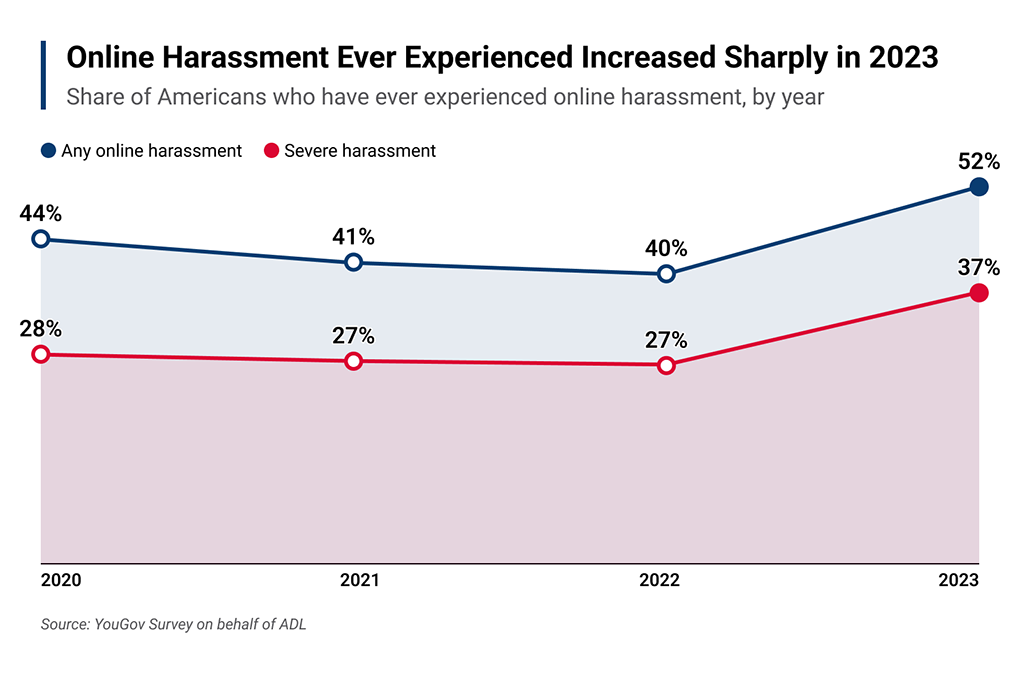
The following graphs show year-over-year findings for the past twelve months, which we started reporting on in 2021, as opposed to lifetime harassment.

Marginalized groups report being harassed for their identity (for example, women for their gender) at higher rates than non-marginalized groups.
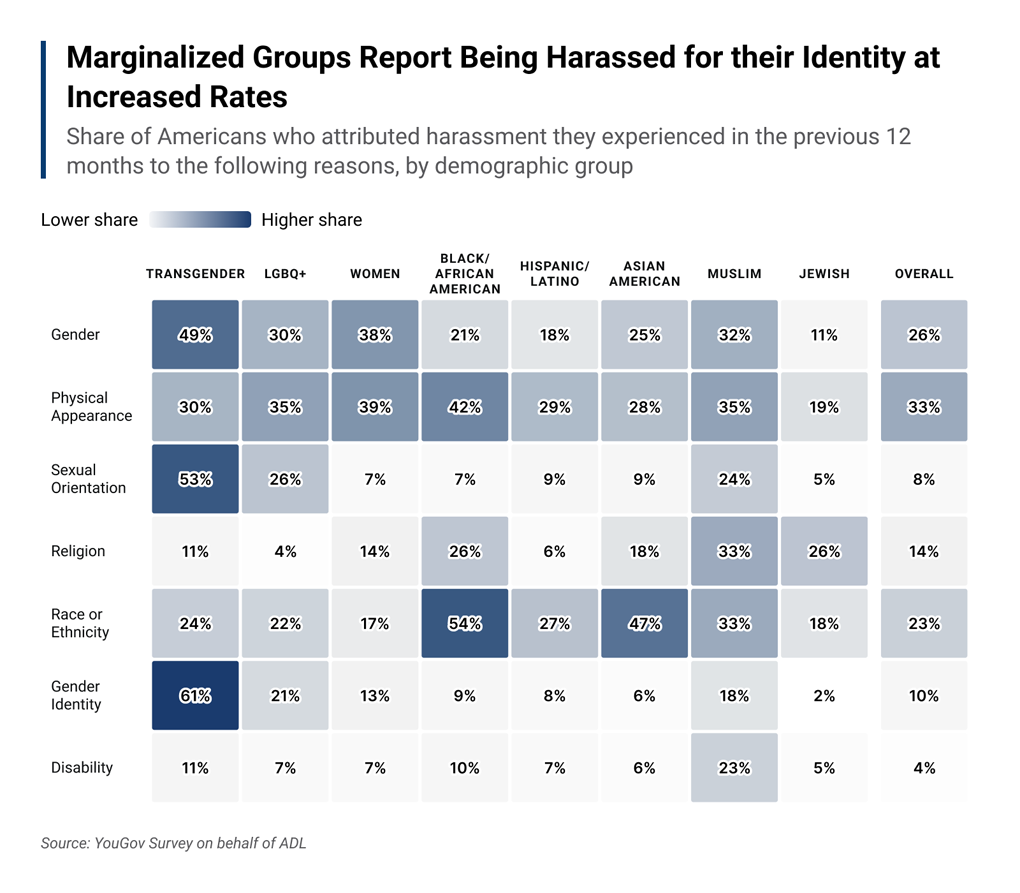
Men and women both reported an increase in harassment, including in severe harassment, in the past twelve months.

Nearly every racial or ethnic group reported an increase in harassment, including severe harassment, except Asian Americans (who experienced a significant increase in 2022).

LGBTQ+ respondents reported the highest rates of harassment among marginalized groups, especially transgender people.
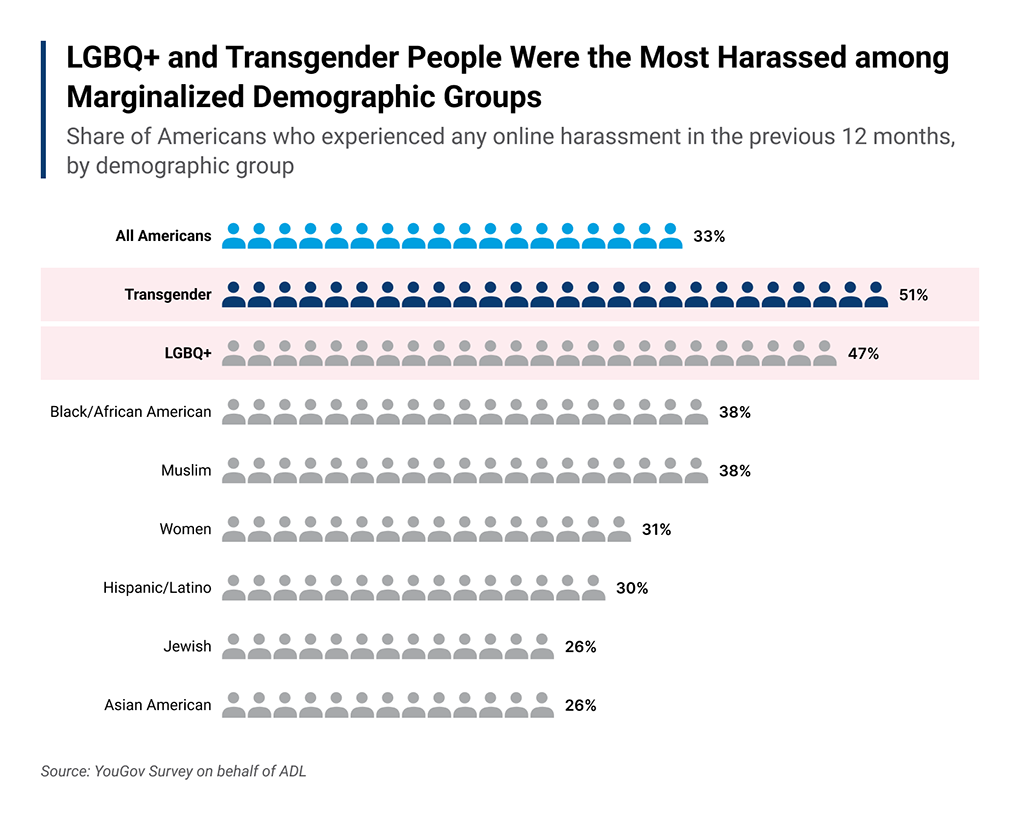
Muslim respondents reported a spike in harassment, due to a sharp increase in sexual harassment.
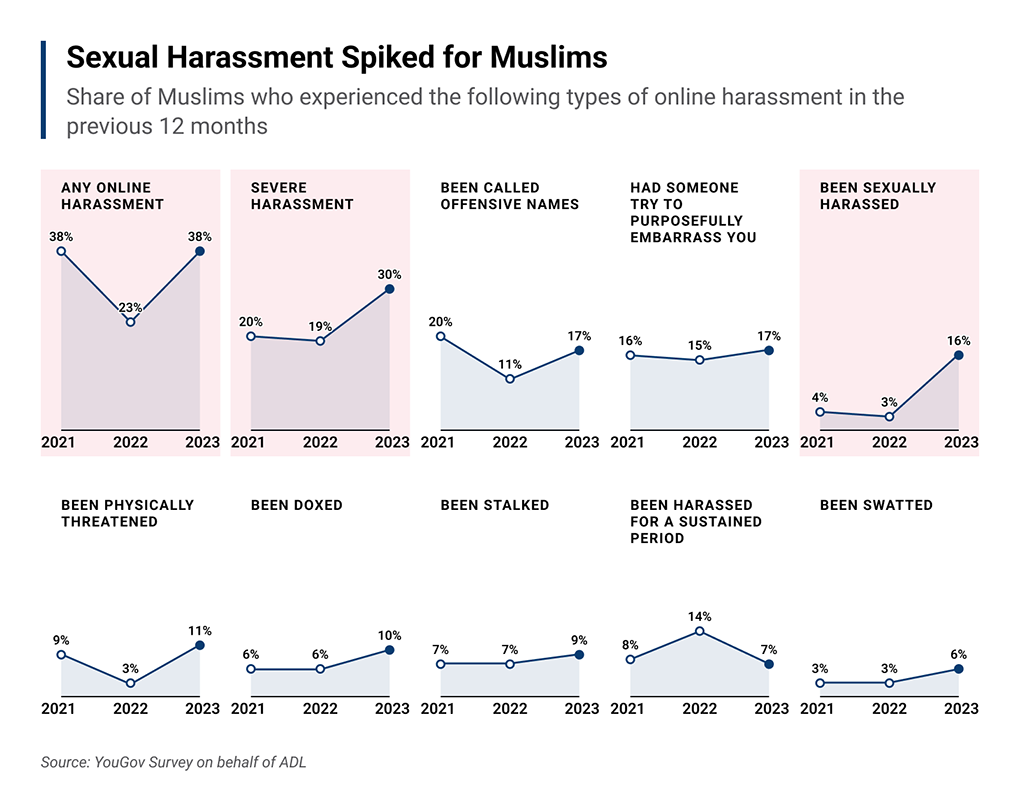
Jewish people experienced an increase in any harassment and in severe harassment.
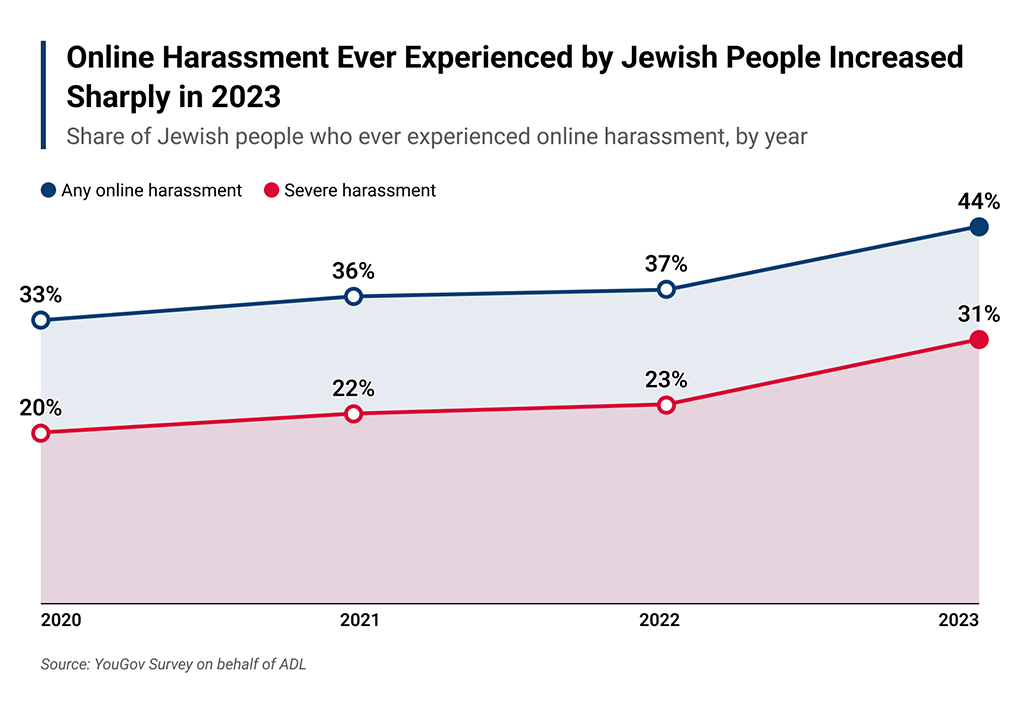
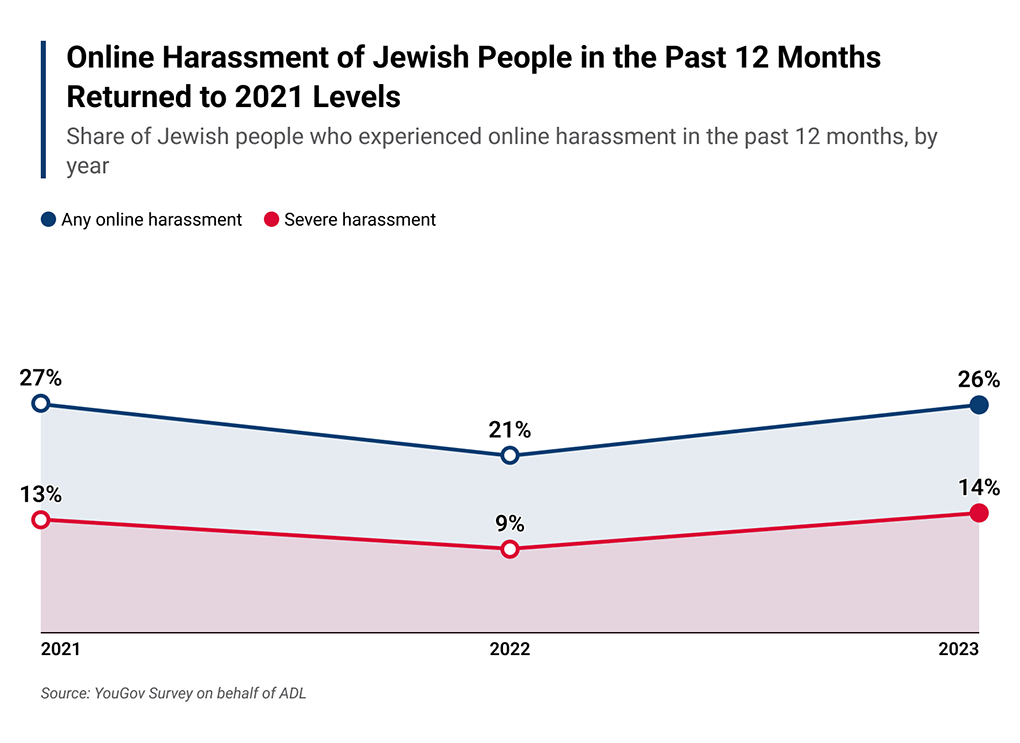
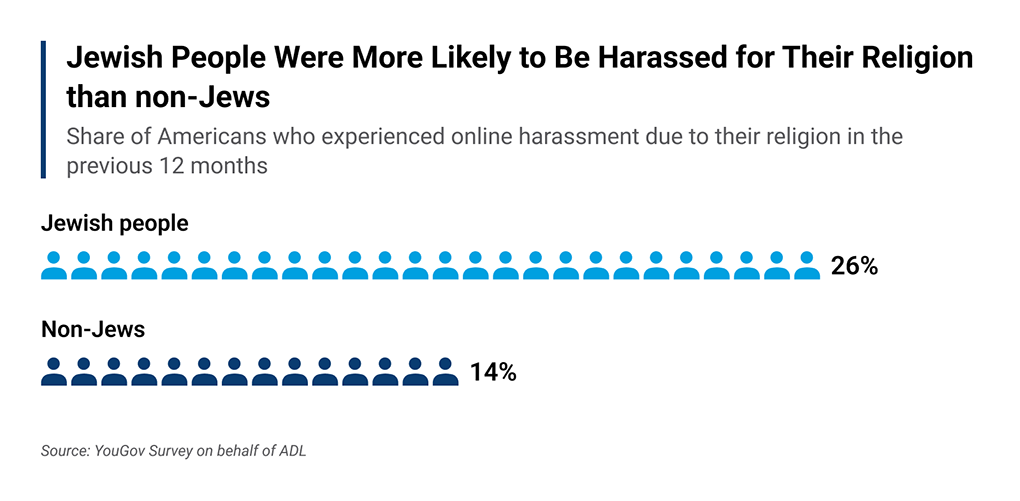
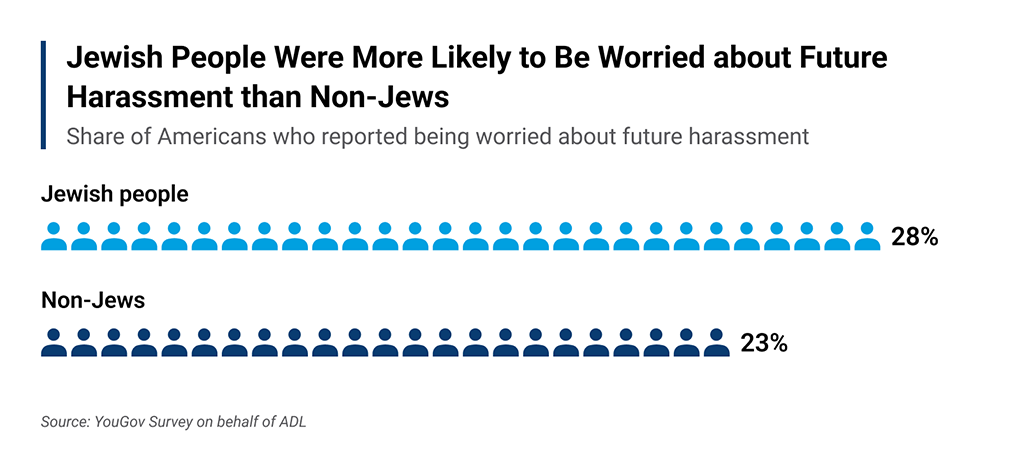
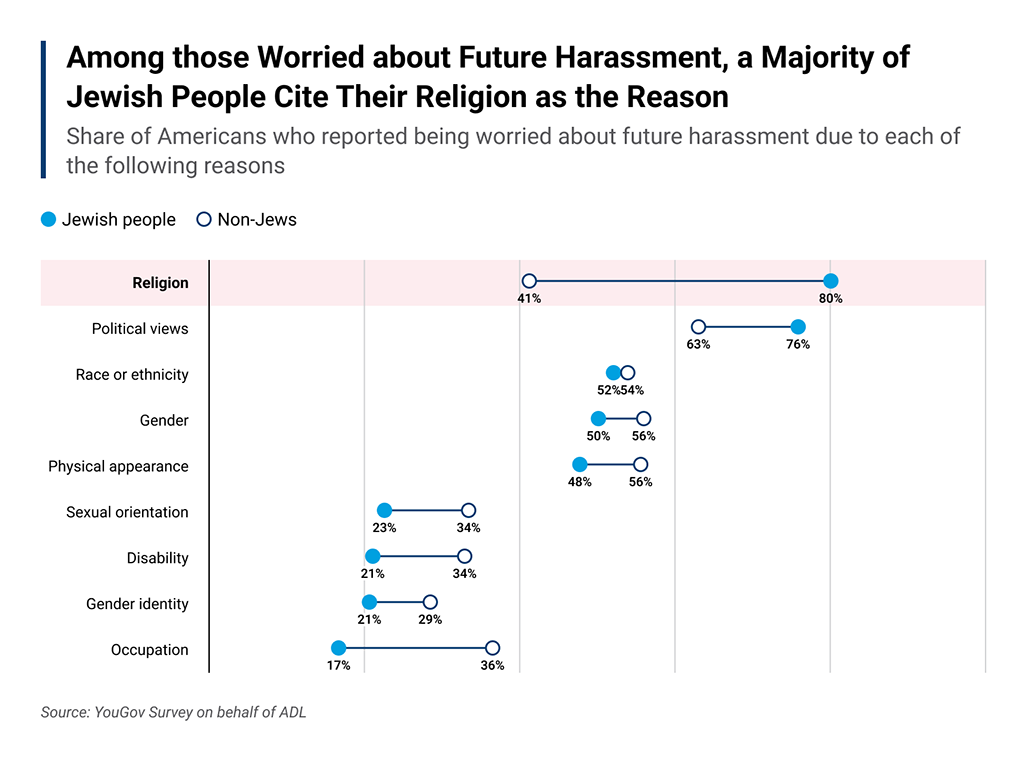
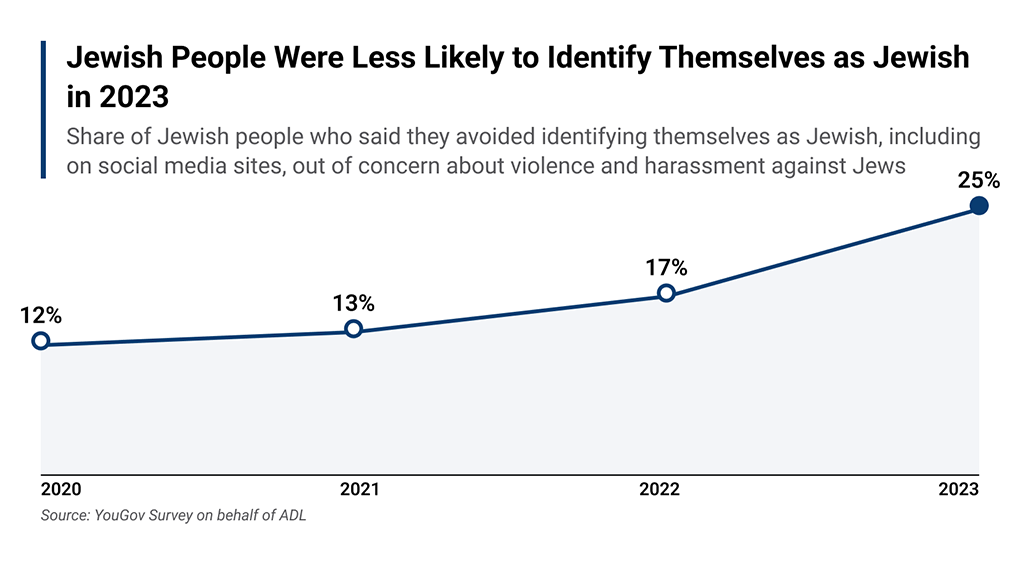
Facebook remains the platform where harassment most commonly takes place, but harassment increased across most other platforms, notably on Twitter, Reddit, TikTok, and Whatsapp.

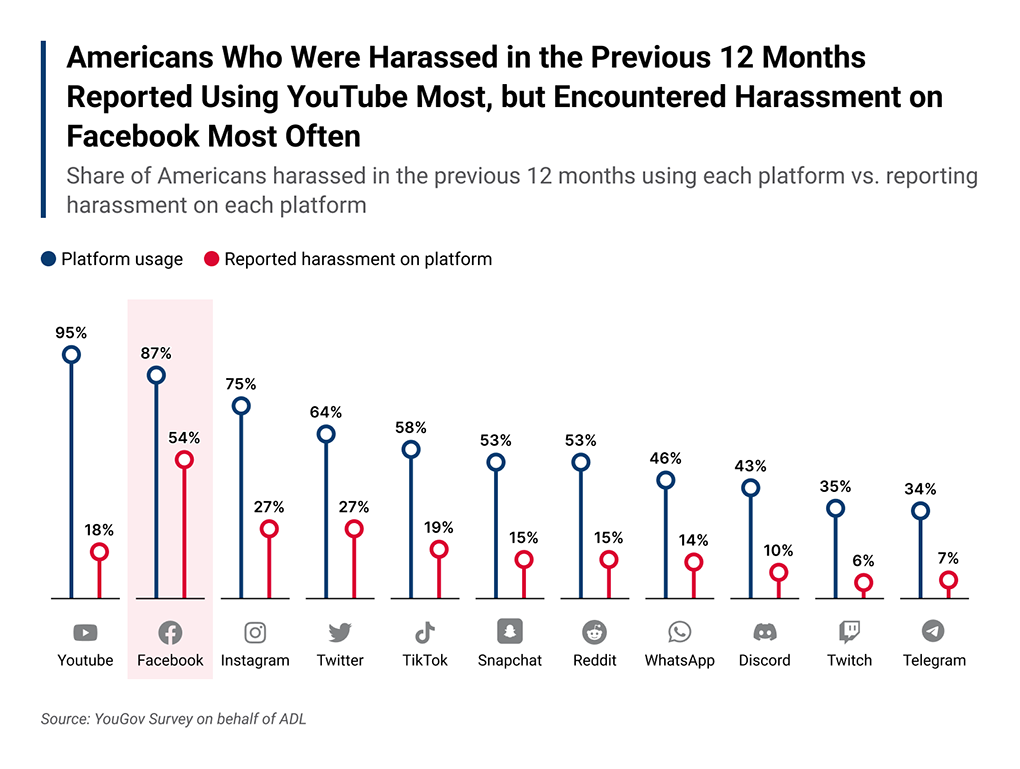
In addition to high rates of harassment, LGBTQ+ people were most likely to be exposed to anti-gay and anti-trans rhetoric and conspiracy theories online.
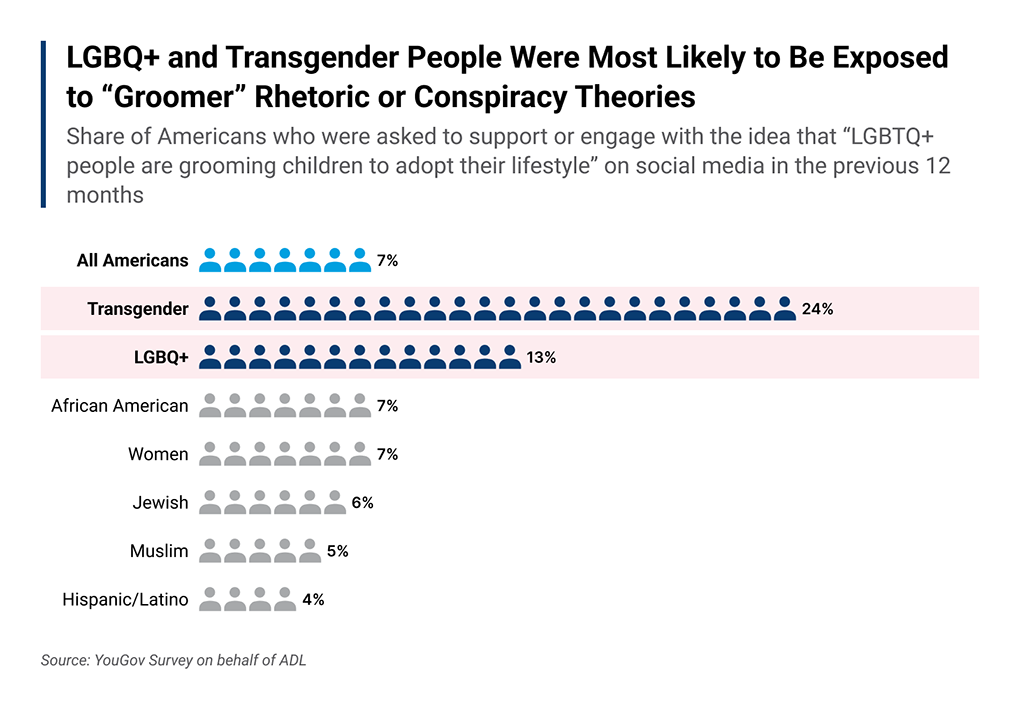
I was called a 'monkey' and an abomination to the human race.
67-year-old Black trans woman
When I report blatant antisemitic posts, I am told that they meet Facebook community standards. I don’t know where to turn. The hate has gotten worse, and Facebook doesn’t even try.
67-year-old Jewish woman
The annual online hate and harassment survey of American adults is conducted on behalf of ADL by YouGov, a public opinion and data analytics firm. The survey examines American adults’ experiences with and views of online hate and harassment. A total of 2,139 completed surveys were collected to form a nationally representative base of Americans age 18 and older, including oversamples from those who self-identified as Jewish, Muslim, Black or African-American, Asian American, Hispanic or Latino, Transgender, or LGBQ+. This was also the first year that we oversampled transgender respondents separate from LGBQ+ respondents. We oversampled the Jewish population until at least 500 Jewish Americans responded. For other oversampled target groups, responses were collected until at least 200 Americans were represented from each. Data was weighted on the basis of age, gender identity, race, census region, and education to adjust for national representation. All respondents were based in the United States, and the survey was conducted in English. YouGov surveys are taken independently online by a prescreened set of panelists representing many demographic categories. Panelists are weighted for statistical relevance to national demographics. Participants are rewarded for general participation in YouGov surveys, but ADL did not directly reward them for their participation in this survey. Surveys were conducted from March 7-24, 2023. Data for ADL’s previous annual online harassment surveys was collected in January 2020, January 2021, and January 2022.
The surveys asked about lifetime experiences online as well as experiences in the past twelve months. The margin of sampling error for the full sample of respondents is plus or minus two percentage points. Unless otherwise noted, year-over-year differences are statistically significant at the 90% confidence level or higher.
The youth survey of 550 13-17-year-olds was also conducted on behalf of ADL by YouGov. Surveys were conducted from March 23-April 6, 2023. The survey examines American teens’ experiences with and views of online hate and harassment. Data was weighted on the basis of age, gender identity, and race to adjust for national representation. The margin of sampling error for the full sample of youth is plus or minus four percentage points.